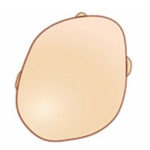The ABC’s of Plagiocephaly (Infant Flat Head Syndrome)
Here is an all-too-common scenario we hear from new parents we hear all the time.
The couple finds out they are pregnant with their first baby. They set up the beautiful nursery, go to all the doctor’s appointments and read everything they can about bringing home a new baby. Baby showers bring lots of blankets, books, diapers, cute little baby outfits and baby gadgets everyone is sure you will need. Baby arrives and their hearts have exploded into a million pieces. They name him Johnny and never did they think they could love something this much. But they do. And they are about to embark on one of the most exhausting, exhilarating, emotional roller coasters of their life. But, despite the lack of sleep and postpartum struggles, they have done very well and Johnny is a chubby, happy and thriving little guy.
They go to their 2 month well check, eager to see how much Johnny has grown and brag about how well he is eating and sleeping. The appointment goes well, then the pediatrician makes a comment about Johnny’s head - it is flat on one side. The doctor doesn’t say much, other than to do some more tummy time and they can check it again at the four month follow up appointment.
Family goes home and does more tummy time, although Johnny would rather just hang out in his bouncy seat or be held. But they keep doing it and before they know it, their sweet baby is 4 months old and it’s time to go back to the doctor. Again, they can’t wait to see how much Johnny weighs and get all the information about what to expect next. Johnny gets his immunizations, they talk about milestones that are coming up and then the pediatrician brings up the head shape again. He said it didn’t get any better over the last few months, in fact, it may have gotten a little worse. He writes a prescription for cranial helmet and advises the parents to make an appointment soon so they can get the head back to a normal shape. Perplexed and saddened, the family goes home to try and research this “infant flat head” thing.
New parents are often blindsided just like this example. They have limited information about this common condition and helmeting is often the only option given to correct their baby’s head. We want to change that! This article is a great place to start. The more knowledge you have about infant flat head syndrome, the better able you are to take action and arm yourself with solutions. For the most part, it is preventable but steps need to be taken very early on in a baby’s life to be successful. Let’s start at the beginning.
 What is infant plagiocephaly?
What is infant plagiocephaly?
Plagiocephaly is a fancy word for “malformation of the head.”
Because a newborn’s skull is very malleable at birth, it is susceptible to forces placed upon it. The American Academy of Pediatrics launched the “Back To Sleep” campaign in 1992, and it has been a huge success in preventing Sudden Infant Death Syndrome (SIDS). (Babies should always sleep on their back, alone, in a crib or bassinet.) With that, however, comes increased pressure on the back of the skull while the baby is sleeping. This can cause misshaping in the back/front and sides of head, even shifting the ears, cheeks and eyes. Flat head syndrome is now affecting close to 50% of newborns each year. Some are very mild, but some are moderate and quite severe.
There are other head shapes that fall under the “plagiocephaly” umbrella. Scaphocephaly is a long and narrowed head shape, common with premature babies or babies that were positioned breech in utero. Another common head shape is “brachycephaly.” It is characterized by flatness across the back of skull and wide above the ears. Both of these head shapes can have asymmetry, so often, we see a combination of these head shapes together.
What Causes Plagiocephaly?
Now that we know what plagiocephaly is, it is also good to know what causes it. There are four risk factors that are worth mentioning.
 1. Back (supine) sleeping
1. Back (supine) sleeping
Check this out – once a baby is two months old, they will probably been on their backs for over 700 hours! That is a lot of time on a soft skull and if your baby tends to always lay on the same side or primarily in one position, that area will flatten and the areas around it will become fuller. Think of how a pumpkin grows on the ground. It becomes misshapen as it gets bigger and is always in the same spot.
 2. Decreased tummy time.
2. Decreased tummy time.
We hear from families all the time – “My baby hates tummy time!” It can certainly be a challenge but let’s first look at why. As babies, being on the back is easier. Being on the tummy is harder because they are working AGAINST gravity. And how do they tell us its hard? They tell us by fussing, grunting and sometimes crying. This makes parents less likely to do it because no one wants to see their baby cry! As a result, this will then increase the time spent on the back of the head which increases the risk of the skull flattening.
 3. Increased container usage
3. Increased container usage
The baby products market is rampant with devices, toys, gadgets, sleep accessories, etc for new parents to buy. They all make big promises about “making baby happy” or “baby will sleep so well”. The downside of these devices – they contain your baby and restrict their normal movement. This is not good for a soft, malleable skull because baby will always be in the same position and not be able to move out of it. Some common “containers” that we see are: bouncy seats, Doc A Tot sleepers, car seats, baby swings, boppy loungers, boppy pillows and Bjorn bouncers. Remember – restricting a baby’s head and neck mobility is NOT a good way to prevent plagiocephaly. We want to give baby the ability to move it in all directions with no limitations. THAT is what will keep it nice and round!
 4. Infant torticollis/Neck muscle imbalance
4. Infant torticollis/Neck muscle imbalance
Torticollis is another fancy word that is thrown around in the plagiocephaly world a lot. It is defined as “twisted neck” but really, it just means that one side of the neck is tighter than the other. This imbalance causes baby to only turn in one direction, especially while sleeping. If this continues for long periods of time, the skull will flatten in that area because of the external force from the bed surface. If this is not addressed quickly, torticollis can affect not only the head shape but also motor development and vision. It is very important for new parents to watch out for a turn preference with their new baby to mitigate these outcomes.
Understanding what causes infant flat head syndrome will help parents of new babies have the tools they need to better understand how to avoid it. Check out What to Do If My Baby’s Head is Flat for tips on ways to stay out of a baby helmet. Remember, Baby Begin is a company dedicated to infant plagiocephaly, torticollis and infant development. Our Instagram/Pinterest are full of great information for new parents. Check us out!
Written by: Jennifer Barnard, Founder, OT

